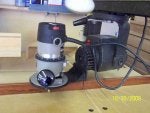I have been wanting a pin router for some time but was not satisfied with what was out there. Meaning I could not afford it or it's purpose for what I wanted it to do was limited.
So I created this one,
The features are;
*Mechanical control of lowering router with foot control.
*I can raise the carriage in the back up to 12" off the table and still have the same foot control.
*I have a slide table for rabbits dado's or cutting tenons.
*The head can angle left or right up to 45 degree's for cross cutting at angles or routing into an angled cut.
* It has a 1/4" pin in it that is adjustable for height and has 1/2" and 3/4" bushings for larger bits.
*It has a stop feature for depth and one to hold it for depth.
*It has a moving measurement rule to set and adjust depths.
*The down movement of the router is run on modified drawer guides encased to help prevent sawdust from entering the bearings.
*The foot control is tied to a floating choke cable. This gives the unit the ability to work mechanically and still have adjustments for height. The foot control gives 5" of vertical movement.
I am really pleased with it and am discovering different ways to use it. I am making a jig to be able to cut and rout circles too.
I will let you know how things go with it.
So I created this one,
The features are;
*Mechanical control of lowering router with foot control.
*I can raise the carriage in the back up to 12" off the table and still have the same foot control.
*I have a slide table for rabbits dado's or cutting tenons.
*The head can angle left or right up to 45 degree's for cross cutting at angles or routing into an angled cut.
* It has a 1/4" pin in it that is adjustable for height and has 1/2" and 3/4" bushings for larger bits.
*It has a stop feature for depth and one to hold it for depth.
*It has a moving measurement rule to set and adjust depths.
*The down movement of the router is run on modified drawer guides encased to help prevent sawdust from entering the bearings.
*The foot control is tied to a floating choke cable. This gives the unit the ability to work mechanically and still have adjustments for height. The foot control gives 5" of vertical movement.
I am really pleased with it and am discovering different ways to use it. I am making a jig to be able to cut and rout circles too.
I will let you know how things go with it.



















